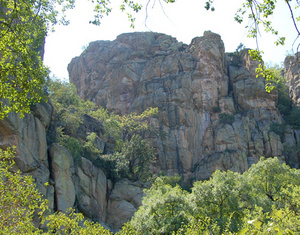Rain Shrines in Botswana
Mike Main about the believe in the power of rain shrines in Botswana
Isn’t it odd: how the past and the present can live side by side? Sometimes it is so easy to miss, just a gentle juxtaposition between then and now, so seamlessly blending, almost unnoticeable. Thinking like this, I often wonder how many rain shrines I have passed without seeing them. Like many parts of the world, Botswana stands with feet firmly in two centuries. Despite being a modern, wealthy and, to some degree sophisticated and nominally Christian country, the power of the ancestors is strong and their influence, although waning, is still powerfully felt, especially in the rural areas. And it is there that calls for rain are most urgent, for crops and grazing are totally dependent upon this annual gift.
My work often takes me to eastern Botswana and the Tswapong hills: an elevated and extensive massif of ancient rocks deeply riven by dark narrow gorges. Here, in these secret places, rain shrines are sometimes encountered. So far as I am aware, there is nothing particular about the locality of any one shrine but, despite the apparently haphazard selection, I do note that the same place is often used for years in succession.
Such a site is usually hidden away, somewhat off the beaten track but no effort is made to hide it. Unexpectedly, round a corner perhaps, on a rocky shelf at the foot of a large boulder, the shrine will be found. Candle stubs and strings of melted wax are the most obvious signs but sometimes there will be a scattering of coinage in small denominations. Not much perhaps, usually amounting to less than a dollar, but a lot of money in the eyes of cash-poor locals and a good measure of the earnestness of their requests.
To this place, in the early morning, usually the older tribal males (but sometimes women) will come. A gift will be brought, perhaps more money will be added and, in the gloom, the candles will be lit as supplications are chanted to the past and desires for the future outlined.
Sometimes on the top of isolated hillocks I have encountered great bonfires-in-waiting. Carefully laid piles of kindling and heavy logs await the match that will set them ablaze. It is the hope of the elders that upwards on the rising smoke, their prayers will ascend to receptive ancestral ears. Around this site there is a scatter of broken pieces of pottery. Some gift, no matter how small, always accompanies a call for rain. Pots will be carried to the site containing grain or meat or some small delicacy that might please a hungry forefather. At Tsodilo Hills a few seeds from the intended sowing are laid out on a rock and sprinkled with water. A few short prayers are said and the seeds left as an ‘offering’.
In Makgadikgadi, there is an island on the edge of this forgotten sea. It is a place of stunning beauty, wild isolation and sterile horizons so distant that it is hard to say where sky ends and earth begins. The island is a low granite outcrop whose massive boulders have been smoothed and rounded by the surging waves of an ancient past. On one of the highest points, cradled within the compass of surrounding summit rocks there is an archaeological site (Leopard’s Kopje) dated to about AD 1200.
The island itself is an increasingly popular destination for self-drive visitors and mobile safaris. I have seen it filled with all the paraphernalia of camping man. Cheek by jowl were: 4X4’s, trailers, gas stoves, rooftop tents, radios, CD players, all the modern high-tech stuff. And yet, simultaneously, on a small round raised rock standing alone among the summit boulders and in the middle of the archaeological site, there was an offering to the spirit world.
Coins, pottery, a few ostrich egg-shell beads from the site itself and a tiny fragment of a blue glass bead. This might have begun life in the Far East or in Persia and passed from hand to hand across the oceans and overland in Africa to end its life on this exotic island. Past and present side by side. One party wanting rain, the other most definitely not! All part of Africa’s fascinating contradictions.
Author: Mike Main

